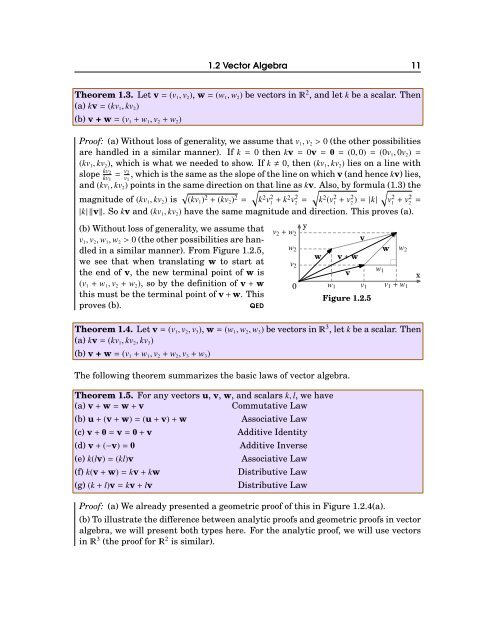Michael Corral: Vector Calculus
Michael Corral: Vector Calculus
Michael Corral: Vector Calculus
Create successful ePaper yourself
Turn your PDF publications into a flip-book with our unique Google optimized e-Paper software.
1.2 <strong>Vector</strong> Algebra 11<br />
Theorem 1.3. Let v=(v 1 ,v 2 ), w=(w 1 ,w 2 ) be vectors in 2 , and let k be a scalar. Then<br />
(a) kv=(kv 1 ,kv 2 )<br />
(b) v + w=(v 1 +w 1 ,v 2 +w 2 )<br />
Proof: (a) Without loss of generality, we assume that v 1 ,v 2 > 0 (the other possibilities<br />
are handled in a similar manner). If k=0 then kv=0v=0=(0,0)=(0v 1 ,0v 2 )=<br />
(kv 1 ,kv 2 ), which is what we needed to show. If k0, then (kv 1 ,kv 2 ) lies on a line with<br />
slope kv 2<br />
kv 1<br />
= v 2<br />
v 1<br />
,whichisthesameastheslopeofthelineonwhichv(andhencekv)lies,<br />
and(kv 1 ,kv 2 )pointsinthesamedirectiononthatlineaskv. Also,byformula(1.3)the<br />
magnitude of (kv 1 ,kv 2 ) is √ √ √ √<br />
(kv 1 ) 2 +(kv 2 ) 2 = k 2 v 2 1+k 2 v 2 2= k 2 (v 2 1+v 2 2)=|k| v 2 1+v 2 2=<br />
|k|‖v‖. So kv and (kv 1 ,kv 2 ) have the same magnitude and direction. This proves (a).<br />
(b) Without loss of generality, we assume that<br />
v 1 ,v 2 ,w 1 ,w 2 > 0(theotherpossibilitiesarehandled<br />
in a similar manner). From Figure 1.2.5,<br />
we see that when translating w to start at<br />
the end of v, the new terminal point of w is<br />
(v 1 + w 1 ,v 2 + w 2 ), so by the definition of v+w<br />
this must be the terminal point of v+w. This<br />
proves (b).<br />
QED<br />
y<br />
v 2 +w 2<br />
v<br />
w 2<br />
w w 2<br />
w v+w<br />
v 2<br />
w v 1<br />
0 w 1 v 1 v 1 +w 1<br />
Figure 1.2.5<br />
Theorem1.4. Letv=(v 1 ,v 2 ,v 3 ),w=(w 1 ,w 2 ,w 3 )bevectorsin 3 ,letkbeascalar. Then<br />
(a) kv=(kv 1 ,kv 2 ,kv 3 )<br />
(b) v + w=(v 1 +w 1 ,v 2 +w 2 ,v 3 +w 3 )<br />
The following theorem summarizes the basic laws of vector algebra.<br />
Theorem 1.5. For any vectors u, v, w, and scalars k,l, we have<br />
(a) v+w=w+v Commutative Law<br />
(b) u+(v+w)=(u+v)+w<br />
(c) v+0=v=0+v<br />
(d) v+(−v)=0<br />
(e) k(lv)=(kl)v<br />
(f) k(v+w)=kv+kw<br />
(g) (k+l)v=kv+lv<br />
Associative Law<br />
Additive Identity<br />
Additive Inverse<br />
Associative Law<br />
Distributive Law<br />
Distributive Law<br />
Proof: (a) We already presented a geometric proof of this in Figure 1.2.4(a).<br />
(b)Toillustratethedifferencebetweenanalyticproofsandgeometricproofsinvector<br />
algebra, we will present both types here. For the analytic proof, we will use vectors<br />
in 3 (the proof for 2 is similar).<br />
x








